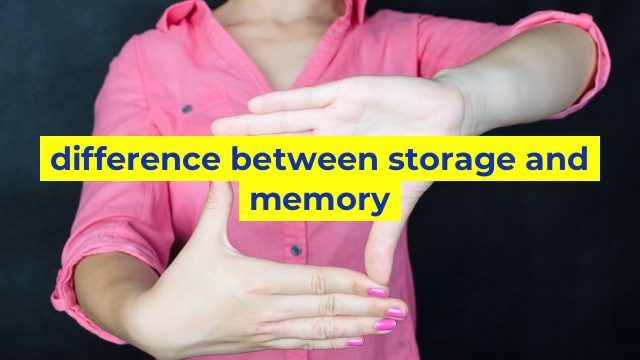The Fundamental Difference between Storage and Memory
Storage and Memory Overview
For many people, “storage” and “memory” are interchangeable terms, especially when referring to a computer’s internal workings. After all, both of them have something to do with holding data, right? Unfortunately, these two terms are not the same and understanding their difference is essential in many aspects of computing.
What is Storage?
Storage refers to the place where data is saved permanently (or at least, for an extended period). It includes hard drives, solid-state drives, external hard drives, USBs, and other types of memory storage devices. In general, the larger the storage capacity, the more data that can be saved on that device. Storage is where files, such as documents, pictures, videos, and music are kept. It is like having a filing cabinet where everything important is placed and can be retrieved.
What is Memory?
Memory, also known as random access memory (RAM), is where data is stored temporarily as a computer or program is running. It is designed to access information, data, and programs quickly to provide the computer with immediate access to the tasks you want it to perform. Memory does not store data permanently as it requires constant power to retain information, meaning that once you turn off your computer, anything stored in memory will be erased.
The Key Differences between Storage and Memory
The significant difference between storage and memory is their purpose, permanence, and speed. Storage is a physical device that holds your data permanently, unlike memory, which is temporary. Memory is designed to retain information until the computer is turned off or restarted, while Storage holds data even when the computer is turned off or restarted. Finally, storage is more capacious but slower than memory, which is much faster but limited to the size of memory modules.
In Conclusion
To sum up, storage and memory are two very different things in computing, each playing a vital role. Storage serves as a long-term archive for your files, while memory is a short-term workspace that your computer uses to access applications and data. Understanding the difference between these two terms will not only help you solve computer-related problems, but it is also crucial in everyday computing to ensure that you use each correctly to optimize your computer’s potential.
Table difference between storage and memory
| Storage | Memory |
|---|---|
| Generally refers to non-volatile media that saves data when the device is turned off | Generally refers to volatile media that holds data temporarily while the device is on |
| Examples include hard drives, solid state drives, USB drives, and external hard drives | Examples include RAM, cache, and registers |
| Used for long-term storage of data and files | Used for short-term storage of data that is required for running programs and processes |
| Can store large amounts of data that is not frequently accessed | Can store small amounts of frequently accessed data that is required for running programs and processes |
| Generally slower to access compared to memory | Generally faster to access compared to storage |

